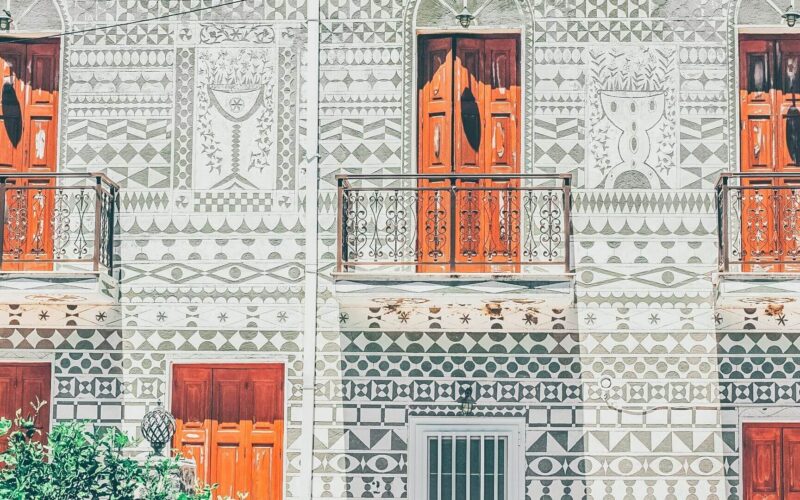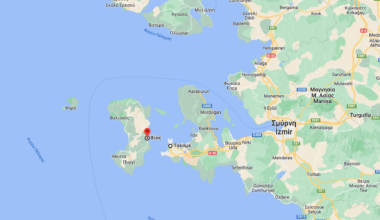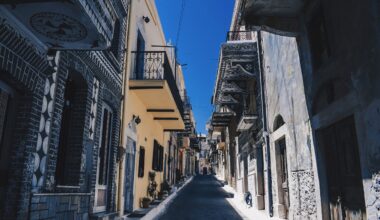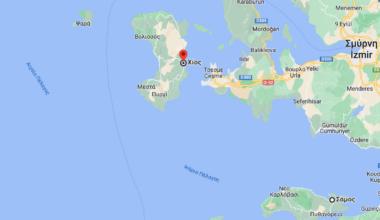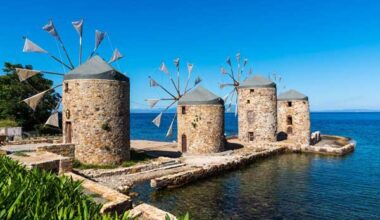- Home
- /
- Chios Travel Guide
- /
- Villages of Chios: Mastic...
Start Booking your trip to Chios Island
We recommend the below options to book your hotels, flights, and activities in Chios island:
flight_takeoffFlights to Chios: kiwi.com
directions_boat Ferries to Chios: ferryhopper.com
bed Hotels in Chios: booking.com
directions_carRent a car in Chios: rentalcars.com
** Please note that we get a small commission if you book via our referral links. We use this to invest in new content and to update the Chios island Greece website.
Table of Contents Show
The Mastic villages, known as Mastihochoria in Greek, are Medieval villages in the South part of Chios. They are 24 villages where mastiha or mastic is harvested.
What are the Mastic Villages?
The southern section of Chios island is known as Mastihochoria. It is the only area in the world where mastic gum, auniquewith special qualities, can be extracted from a mastic tree. Chios mastic gum manufacture provided this regioande as well as the attention of pirates and conquerors.
Each ruler that occupie the island, built military systems and towns that concentrated the production of mastic in specific regions because of the constant threat that he faced. Settlement development and defense go back to Byzantine times, but they reached their zenith when Genoa ruled the island. Even after centuries of destruction and calamity, the communities are still priceless historicources today.
The Mastic villages history
The mastic villages are a collection of fortified settlements constructed under Genoese authority in the 14th century (1346-1566). The Genoese built strongholds to defend this settle they reliever reliance on the production of mastic, a gum-like substance from the island’s distinctive mastic trees.
During the Massacre of Chios, the mastic villages were spared.
The medieval villages’ architecture
The villages were constructed by Latin architects, building firms, anbyordance with the style of the Italian architecture of the time. In the middle of each community, close to one another, were constructed rectangular towers and homes. Farmers from the area had to help with the construction as well.
A central tower served as a final resort in case the high walls surrounding these c which were constructed out of sight from the sea and encircled by high walls, were breached by the Arabic pirates who ravaged the Mediterranean beaches.
The dwellings were constructed with cylindrical turrets with loopholes in the corners, forming a defensive wall with their outer perimIn addition to safeguarding the community, this architectural design facilitated total control over the farmers. eter walls. The assailants could not easily reach the tower, which was the center of the village, because the streets were so small and many of themthe farmers.
Germata
The stone homes in the villages have a ground level and a first story, and a semicircular dome covers them (so-called germata). The main dwelling is typically buried on the upper floor, with stables and storage spaces for agricultural goods being found on the lower floor. The “main openoroomn main space, was utilized for relaxing and sunbathing.
All lofts were constructed to the same height to enable people to flee from one home tohe event of danger. The Genoese nobles moved into the towers after construction was finished, and the local farmers were compelled to relocate intbuilt constructed homes.
As an illustration, at least 14 historic communities were relocated to Pyrgi, a town established at the beginning of the 15th century in the center of the Mastichochoria region.
The medieval villages of Chios
These lovely villages, which have not altered since Byzantine times, are a must-see when visiting Chios are Pirgi, with its beautifully painted homes, Olympi, the most striking of these settlement south of which are still largely intact examples of medieval fortified towns. We highly recommend booking a rental car in advance to discover the mastic villages at your own pace.
Looking to rent a car in Chios? We got you covered!
1. Armolia, Chios
We begin at one of the mastic villages, Armolia, which is renowned for its intricately decorated pottery jugs, mu,gand well as for their small streets and arches that let us see them before they were completely demolished and rebuilt.
A prominent spiritual and intellectual center in the 18th century, the Zoodochos Pygi Monastery was destroyed in the 1822 murders. Exactly one monk resides there at the moment after being refurbished in 1828. On a nearby hill stands the 15th-century Byzantine Castle of Apolyhnon Castle of Apolichnon.
2. Kalamoti, Chios
Located in the island’s southeast, Kalamoti is one of the most significant communities, surrounded by fruit and olive trees. About 850 people live in the village, most the majority of whom work in the mastic industry.
You may observe the two-story homes and elaborately carved doors as you stroll through the village. You can tell how significant this settlement was to the Genoese by looking at the two defensive towers and the walled boundary.
Visit Panagia Agrelopousaina and Agia Paraskevi churches as well as Varvakas, the settlement’s center.
Additionally, proceed to the Profitis Ilias temple, where you can climb the hill and take in a stunning panorama of the island.
3. Vessa, Chios
The village of Vessa, which is dominated by castles, is located around 19 miles from Chios Town. It’s worthwhile to stroll around the winding alleyways and take in the houses’ remarkable architecture, which is still in place. Visit the Agios Dimitrios church as well to see its exquisite icons.
Vessa in Chios is a small, exquisitely maintained town distinguished by its towers and defensive walls. Make sure to eat in a traditional taverna in the town square if you haven’t already. Another charming medieval settlement, it’s a stroll.
4. Olympi, Chios
One of the most impressive mastic villages is Olympi, which is only a short distance from Pirgi. This village’s exterior wall is still even though he fact that doors and windows have been carved out of it. A lovely little square, a few cafeneon-restaurants, and the church of Agia Paraskevis are all there.
Olympi provides an outstanding impression of the measures adopted to preserve the mastic villages with its connected housing walls and 20-meter tower in the village center. Despite being in ruins, the central tower is still standing.
Visit Agia Paraskevi, which has an elaborately carved wood iconostasis, and other medieval churches, like the Trapeza of Olymbi (a two-floor medieval building once used for weddings).
Impressive stalactites and stalagmites can be seen in a nearby cave that goes by the name of Olymbi.
Don’t miss out on a visit to one of Chios caves, the Cave of Olympi, which is a short distance away from Olympi villages and has the most stalactites and stalagmites per square meter of any cave in the Balkans.
5. Pirgi, Chios
Pirgi is the most significant medieval settlement and the biggest among the mastic villages. In the form of sketches and paintings of its ceramic “xysta,” Pyrgi has a reputation that precedes it. The fronts of houses are decorated with these intricate and beautiful black-and-white geometric patterns. Enjoy the artwork as you leisurely stroll around the cobblestoned passageways.
Visit the 13th-century Byzantine church of Agios Apostolos, one of many, before you depart.
6. Mesta, Chios
One of the best-preserved mastic villages is the one that is located in the farthest south of Chios, 35 kilometers southwest of Chios Town. With only two roads in and out of the village, Mesta is another settlement whose design reflects both the wealth and defensive requirements of mastic manufacturing.
It is the island’s best-preserved medieval settlement, and because the homes are situated next to one another, they form a fortified wall. The central area is where you’ll find a local hotel, a few stores, and restaurants after passing through the picturesque small cobbled streets.
The largest Greek Orthodox church on the island and one of the greatest in all of Greece, Megalos Taksiarhis (church of the Archangels), is also located here. It was ereexact in the same location as the original castle tower in the middle of the nineteenth century.
The hamlet also offers a nice range of cafes and tavernas where you may sample loukoumades (fried honey balls), and Chios spirits such as local wine, or souma, an alcoholic beverage similar to ouzo made by distilling figs.
7. Emporio, Chios
Head to Emborio, which is close to the island’s southeast tip. A temple to Athena and other structures, including a sanctuary to the Goddess close to the harbor below, have been found during excavations in the town, which is thought to be the ancient Leukonion mentioned by Thucidides.
Excavations have uncovered more than fifty homes, and as work moves forward, more are anticipated. The black pebble beaches of Mavra Volia and Foki, which resemble the well-known black sand beaches of Santorini, are the result of the extinct volcano of Psaronas, which rises close to the contemporary settlement.
They are some of the most beautiful beaches on all of the Greek islands, but they get crowded on summer weekends, so either leave town by then or use Sunday to explore the rest of the island before heading back to your hotel in the evening after the kids have left.
Mastic Villages in a wrap
Heading south of Chios is a must even if you are going weekend in Chios. If you happen to be there in March a great surprise will expect of you! You will be lucky enough to see the “lalades,” or wild tulips, which make for one of the most distinctive-looking fields.
Let us know in the comments section below: Have you visited the mastic villages? Which one did you like best?
